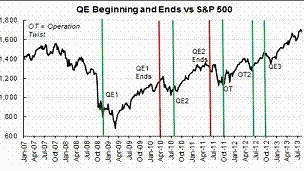The Federal Reserve's postponement of any tapering effort announcement gave investors a lot to consider and MoneyShow's Howard R. Gold thinks, while several hurdles have been cleared for the markets, there's still a long way to go.
The Federal Reserve kept the punch bowl spiked a little longer in a surprise decision that postponed investors' day of reckoning with reality.
On Wednesday, the Federal Open Market Committee voted to maintain its $85-billion monthly bond buying program, defying expectations of two-thirds of economists polled by The Wall Street Journal, who were looking for the central bank to begin tapering its extraordinary bond purchases at this month's meeting.
The reason? The FOMC just hasn't seen the kind of economic growth many gurus and pundits have. “The Committee sees…growing underlying strength in the broader economy,” its statement said. “However, the Committee decided to await more evidence that progress will be sustained before adjusting the pace of its purchases.”
“With unemployment still elevated and inflation projected to run below the Committee's longer-run objective, the Committee is continuing its highly accommodative policies,” Fed chairman Ben Bernanke said at a subsequent news conference.
"I don't recall stating that we would do any particular thing at this meeting," he added in response to a reporter's question.
The Dow Jones Industrial Average and the Standard & Poor's 500 Index immediately spiked to all-time highs as Investors gobbled up stocks right after the news broke.
They were apparently stunned that, what one money manager called “hands down the single most clearly telegraphed move in the history of monetary policy,” would have to await another day.
Apparently, so will the return to a more normal monetary policy, even one with extra low interest rates but without the crutch of $1 trillion a year in additional bond buying.
That could keep stocks rallying off sheer animal spirits and the adrenaline of Fed purchases. And the market already has effectively cleared two of the five hurdles I said it would face this fall.
- Read Howard's piece 5 Hurdles the Markets Must Clear This Fall on
MoneyShow.com.
The threat of US military action in Syria is off the table, because of the collapse of President Obama's efforts to persuade Congress to authorize the use of force and the subsequent offer by Russia to turn its ally Syria's chemicals over for inspection and destruction.
Whether you believe this deal or not, the market sure does: Crude oil prices have fallen 6% since they peaked in late August, while gold prices have dropped 7.5% over the same period, before Wednesday's rally.
Stocks have been further buoyed by Sunday's news that former Treasury Secretary Larry Summers had withdrawn his name from consideration as Bernanke's replacement.
That made Fed vice-chair Janet Yellen the odds-on favorite, even though President Obama doesn't seem to like her very much. But Wall Street does for her long experience, track record of building consensus, and especially her reputation as a dove on monetary policy, which means she might take her time tapering. Perhaps she's exerting her influence already.
NEXT: Where things get tricky
|pagebreak|Indeed, after dropping 4.5% from its August 2 all-time high, through the end of last month, the S&P 500 has rallied 5% so far in September, retracing its August losses.
But here's where things get tricky.
By postponing the decision to October or even December, the FOMC may be setting the market up for an even larger correction when it finally bites the bullet.
As this chart shows, every time the Fed has phased out one of its programs over the last few years, stocks have dropped—first in early 2010, with the winding down of QE1; then in spring 2011, when QE2 ended, and finally in 2012 with the end of Operation Twist. In fact, stocks rallied again only when the Fed announced, or started, a new round of stimulus.
Source: Variant Perception. Reprinted with permission.
And a couple more shoes may drop this fall: The German election will come this weekend, then we face what could be some bruising budget battles, as hard-line House Republicans vow to either shut down the government or not extend the debt ceiling unless Obamacare is defunded, a move even the conservative Wall Street Journal editorial page likened to Kamikaze missions.
If that happens, the government could run out of money to pay all its bills by mid-October, and we could have a crisis similar to the one we had in August 2011, which pummeled stock prices. The odds of such a stand-off are now rising, although I believe a bad deal is still the most likely outcome.
(Bernanke's statement at his news conference pointedly said: “…Upcoming fiscal debates may involve additional risks to financial markets and to the broader economy.”)
Nonetheless, the economy is slowly improving (although not enough for the Fed), profit growth looks good, even as revenue growth doesn't, and stock valuations aren't exorbitant. As investors retreat from bonds, stocks have become more and more attractive.
So, we may see a continued rally, followed by volatility and serious profit taking, maybe even a 10% or so correction. But then investors will realize tapering isn't the end of the world, and they'll start buying stocks again.
- Read about Laszlo Birinyi's prediction that the S&P will top 2,000 on MoneyShow.com.
Still, we're in the seventh or eighth inning of this four and a half year bull market, so I'm sticking to my target stock allocation and am prescribing a large dose of caution, no matter what happens in the months ahead. The Fed's surprise decision Wednesday only postpones the big decisions investors have to make about whether to stick with stocks for the very long run.
Howard R. Gold is editor at large for MoneyShow.com and a columnist with MarketWatch. Follow him on Twitter @howardrgold. For more information, and to register for FREE for an upcoming eMoneyShow event, click here






















